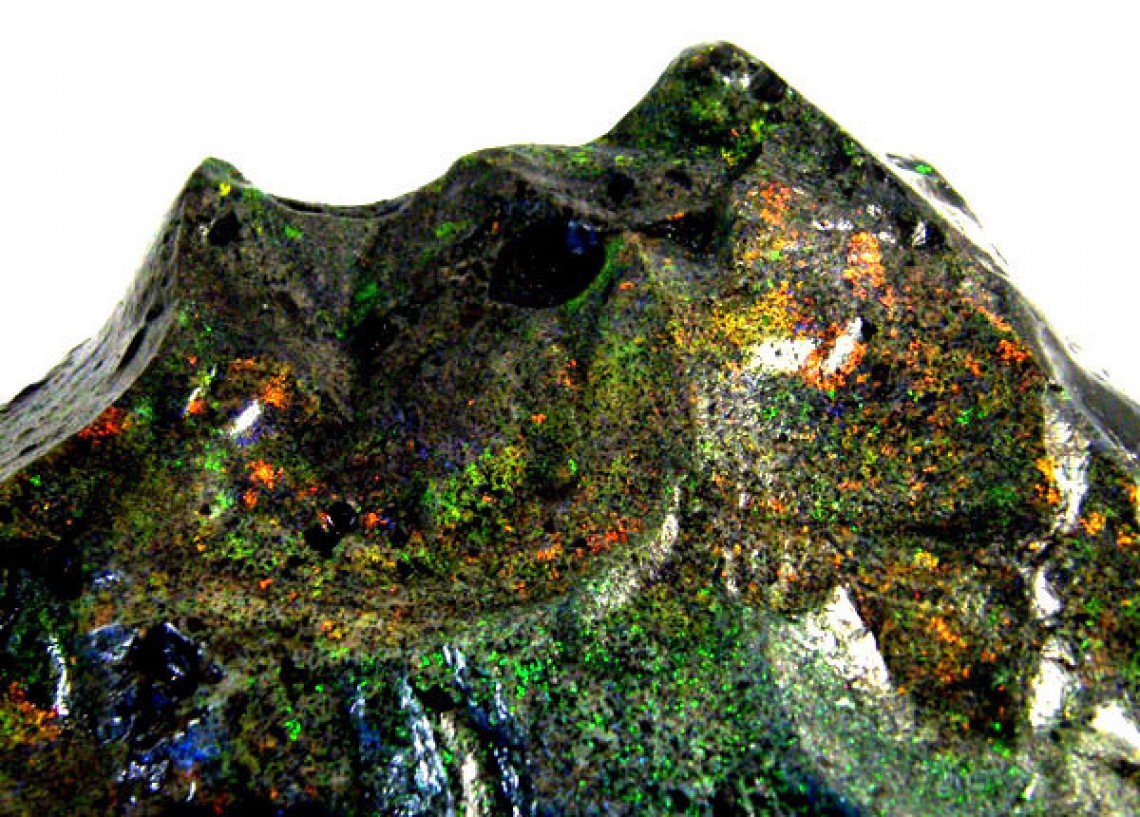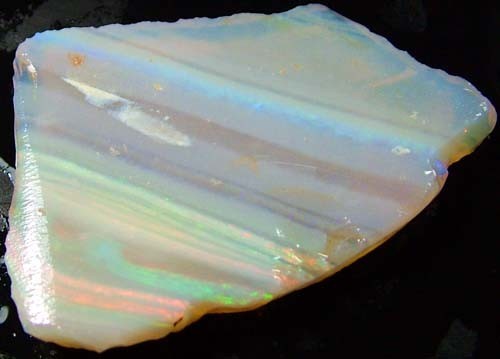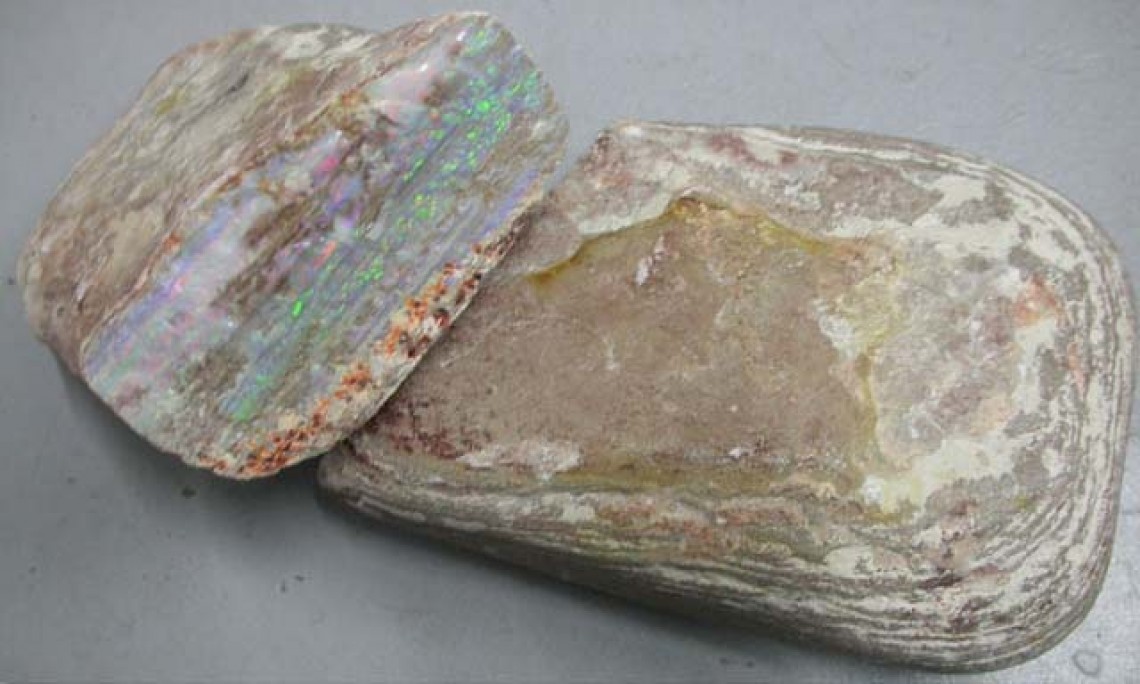
Geschichte des Andamooka-Opals und seine Behandlung

[Lesezeit: 10 Minuten]
In Südaustralien wurde Opal erstmals in den 1930er Jahren in Andamooka entdeckt. Der erste Andamooka-Opal wurde von Sam Brookes und Roy Sheppard gefunden. Während eines Gewitters suchten sie unter einem Baum Schutz, als ihnen ein hübscher Stein ins Auge fiel. Später wurden kleinere Vorkommen freigelegt, darunter Lambina im Jahr 1930 und Stuart Creek im Jahr 1947. Der Opal von Andamooka befindet sich im dünnen marinen „Bulldog Shale“, der den bedeutendsten Teil der Marree-Untergruppe aus der frühen Kreidezeit bildet.
Zusammenfassung
Andamooka ist eines der ältesten bekannten Opalvorkommen Australiens.
Opale aus Andamooka wurden in den Schmuckstücken der Königin verwendet.
Andomooka-Opal kann mit Zucker behandelt werden, um ihn schwarz zu färben und das Farbenspiel des Opals zu verbessern.

Berühmter Andamooka-Opal
Der Andamooka-Opal ist auch als „Königinnenopal“ bekannt. Er wurde 1954 geschliffen und in ein 18-karätiges Palladium-Halsband gefasst. Königin Elizabeth II. erhielt ihn anlässlich ihrer ersten offiziellen Staatsreise nach Australien. Heute zählen Halskette und Ohrringe zu den bedeutendsten Kronjuwelen von Königin Elizabeth II. Der Opal wog 203 Karat.

Andamooka, 1930 entdeckt, gilt als eines der bedeutendsten Opalvorkommen Australiens. Hier wurden einige der schönsten Opale gefunden, darunter der bereits erwähnte „Andamooka Matrix Opal“, auch bekannt als „Queen’s Opal“. Der Name Andamooka stammt aus der Sprache der Aborigines und bedeutet „großes Wasserloch“. Die Stadt liegt 600 Kilometer nördlich von Adelaide und ist die einzige australische Stadt, in der keine Straße einen Namen trägt.

Andamooka Opalbehandlung
Die Opalminen von Andamooka sind bekannt für die Gewinnung von hellem Opal, der aus weißem, kristallinem Opal besteht und manchmal auch als „Milchopal“ bezeichnet wird.
Matrixopal ist ein durchlässiger Opal, der aus Andamooka in Südaustralien stammt. Auch eine Varietät von Boulderopal kommt in Andamooka vor. Da das Gestein in der Umgebung größtenteils aus Quarzit besteht, bildet sich der Opal manchmal zwischen diesem sehr harten Gestein. Diese Opale werden als „Painted Ladies“ bezeichnet.

Andamooka-Matrixopal wird regelmäßig behandelt, um seine Farbe durch die Erzeugung eines schwarzen Körpers mit Ruß zu verbessern. Diese Behandlung umfasst eine chemische Behandlung, die auf den gesamten Stein angewendet wird. Direkt nach dem Abbau kann er recht pastös wirken, doch durch die Behandlung mit Ruß erhält er ein ansprechenderes Aussehen.
Nach der vollständigen Behandlung spricht man von Andamooka-behandeltem Matrixopal. Dabei wird der Opal zunächst in einer Zuckerlösung aufgelöst und anschließend in einem Bad mit konzentrierter Schwefelsäure geköchelt. Der Zucker dringt in die Kalksteinmatrix ein, die Säure erhitzt sie und wandelt den weißen Zucker um die Opaleinschlüsse in schwarzen Kohlenstoff um. Das Ergebnis ist eine dunkle Matrix, die die Opaleinschlüsse umschließt und kein Licht bricht. Einige Minenarbeiter verkauften die Originale als Lightning Ridge Black Opal im Ausland. Nachdem der Betrug aufgedeckt wurde, kaufte niemand mehr behandelten Matrixopal. Doch die außergewöhnlichen Farben und die tiefschwarze Matrix der besten Exemplare sind genau die Eigenschaften, die den Lightning Ridge Black Opal berühmt gemacht haben. Die Behandlung dieser Matrixsteine ist ein vergleichsweise einfaches Verfahren.
 Manchmal wird ein Epoxidharz verwendet, um den Steinen einen schönen Glanz zu verleihen. Sie finden es hier .
Manchmal wird ein Epoxidharz verwendet, um den Steinen einen schönen Glanz zu verleihen. Sie finden es hier .

Andamooka-Dinosaurierknochen
In Andamooka wurden Dinosaurierfossilien und -knochen gefunden, von denen viele heute in Museen ausgestellt sind. Australische Dinosaurier sind 100 bis 240 Millionen Jahre alt und stammen somit aus dem Jura und der Kreidezeit. Dinosaurierknochen sind in vielen Ländern bekannt, doch nur in Australien wurden opalisierte Dinosaurierfossilien gefunden.
Andamooka Opal Preis
Matrixopale können recht günstig sein, im Gegensatz zu echten schwarzen Opalen. Käufer sollten sich daher bei einem Opalhändler vergewissern, ob es sich um authentische schwarze Opale oder Andamooka-Matrixopale handelt. 
Wie man Andamooka-Matrix-Opal behandelt
Die benötigte Ausrüstung ist sehr einfach. Zum Erhitzen eignet sich eine alte elektrische Bratpfanne mit Thermostat. Es ist sehr wichtig, den Opal nicht zu überhitzen, da er sonst brechen kann.
Eine Mischung aus 1 Tasse Zucker (weiß oder braun scheint keinen Unterschied zu machen) in eine Pyrex- oder andere hitzebeständige Schüssel mit der gleichen Menge Wasser geben und erhitzen, bis sich der Zucker aufgelöst hat.
Die Bratpfanne zum Erhitzen auf mittlere Stufe stellen. Die Pyrex-Schüssel kann direkt auf die Bratpfanne gestellt werden.
Vor der Weiterverarbeitung muss der Matrixopal geschnitten, geformt und geschliffen, aber nicht poliert werden. Anschließend sollte er durch leichtes Erwärmen gründlich getrocknet werden, um jegliche Feuchtigkeit aus den feinen Poren des Steins zu entfernen. Vermeiden Sie es, den Stein mit den Fingern zu berühren, da das Hautfett die Behandlung beeinträchtigen kann.
Die Steine werden anschließend in den Zuckersirup gelegt und mindestens 8 Stunden gekocht. Die Kochzeit ist etwas ungenau und hängt von der Porosität der Steine ab. Sehr poröses Material saugt den Zuckersirup deutlich schneller auf als dichtes. Ich weiß nicht, wie man die genaue Kochzeit bestimmen kann, aber 8 Stunden scheinen ein guter Ausgangspunkt zu sein.
Lassen Sie die Masse nach dem Kochen abkühlen. Gegebenenfalls muss in dieser Phase etwas Wasser zur Zuckerlösung hinzugefügt werden, falls diese durch Verdunstung während des Kochvorgangs zu dickflüssig wird.
Der nächste Schritt ist äußerst gefährlich, da er die Verwendung hochkonzentrierter Schwefelsäure beinhaltet. Diese ist stark ätzend, und auch ihre Dämpfe können gefährlich sein.
Verwenden Sie 93%ige Schwefelsäure, die Sie von einem Chemikalienlieferanten beziehen.
Eine kleine Menge in eine Pyrex-Schüssel geben und diese in die Bratpfanne stellen. Die Bratpfanne befindet sich in einem gut belüfteten Schuppen.
Beim Einfüllen der Säure in die Schüssel empfiehlt es sich, Gummihandschuhe und eine Schutzbrille zu tragen, da die Säure bei Hautkontakt schwere Verätzungen verursacht. Seien Sie daher vorsichtig. Schütten Sie die Säure niemals in Wasser, da sie heftig reagiert und Sie verspritzen könnte. Tragen Sie am besten zusätzlich eine Atemschutzmaske.
Die Steine werden vorsichtig mit einer Kunststoffpinzette (keine Metallpinzette, da diese mit der Säure reagiert) aus der Zuckerlösung entnommen und nach dem Abtropfen der überschüssigen Zuckerlösung vorsichtig in die Säure gelegt. Die Steine dürfen jetzt nicht abgewischt werden. Anschließend können sie mindestens zwei Stunden in der erwärmten Säure gekocht werden. Dabei haben sie ihre Farbe verändert. Danach können sie vorsichtig mit einer Kunststoffpinzette entnommen und in eine Schüssel mit einer schwachen Zuckerlösung oder einer Natronlösung gegeben werden, um die Säure zu neutralisieren.
Nach wenigen Minuten kann man sie bereits bewundern, obwohl noch der letzte Feinschliff nötig ist. Im nassen Zustand sieht man die erstaunliche Verwandlung, die stattgefunden hat. Die Farben des Opals kommen nun deutlich zur Geltung.
Bei dichtem Gestein lässt sich der Stein nun polieren. Verwenden Sie besser kein Ceroxid oder Zinnoxid, da die Poliermittel in die Poren eindringen und als winzige weiße Punkte die Oberfläche beschädigen können. Polieren Sie den Stein mit einem Lederpolierlappen und Diamanten der Körnung 50.000.
Besondere Vorsicht ist geboten, um nicht zu viel Druck auszuüben, da dies zu starker Hitzeentwicklung und Rissen im Stein führen kann. Porösere Gesteinsarten lassen sich unter Umständen gar nicht polieren. In diesem Fall kann die Oberfläche mit Flüssigglas behandelt werden, um einen Hochglanz zu erzielen. Ich werde diese Behandlungsmethode in einem separaten Beitrag erläutern.
Vergessen Sie nicht, die Säure sorgfältig zu entsorgen. Geben Sie die Säure sehr langsam in Wasser und vergraben Sie die stark verdünnte Lösung im Garten. Geben Sie kein Wasser direkt zur Säure, da diese spritzen und Sie leicht verletzen kann. Sollte es dennoch zu einer Spritzerbildung kommen, waschen Sie die betroffene Stelle gründlich mit Wasser ab. Wenn Sie Anmerkungen zu dieser oder anderen Behandlungsmethoden haben, teilen Sie diese gerne mit. Ich habe mit dieser Methode gute Erfahrungen gemacht und besitze nun wunderschöne Steine, die hochwertigem schwarzem Opal sehr ähnlich sehen und im Vergleich dazu sehr wenig gekostet haben.
Andamooka-Opal kaufen
Suche nach Opal Encyclopedia
Verwandte Auktionen
In Verbindung stehende Artikel
Die NASA entdeckte zunächst Opal auf dem Mars und hat nun bestätigt, dass es dort fließendes Wasser gibt. Erfahren Sie, wie die beiden Entdeckungen zusammenhängen.
22nd Jun 2017
Haben Sie sich jemals gefragt, welche Tiere des australischen Outbacks in den Opalfeldern vorkommen? Begleiten Sie uns auf unserer Entdeckungsreise in die aufregende Welt des Outbacks!
22nd Jul 2020
Was bedeutet „Down Under“? Erfahren Sie mehr über die Geschichte des Ausdrucks, seine Bedeutung und wie er zu einer Bezeichnung für das Land und den Kontinent Australien wurde.
7th Sep 2020
Neue Artikel
Schwarze Opale sind die begehrteste Opalart. Ihre tiefe Basis erzeugt ein regenbogenfarbenes Farbenspiel an der Oberfläche. Entdecken Sie die Verwendung, Eigenschaften, Geschichte und den Wert schwarzer Opale!
7th Dec 2025
Erfahren Sie, wie Opale bewertet werden und welche Faktoren ihren Preis beeinflussen. Von Farbe und Leuchtkraft bis hin zu Schliff und Herkunft – lernen Sie, wie die verschiedenen Opalarten bewertet werden, inklusive Preisbeispielen.
19th Jul 2023
Begeben Sie sich auf eine Reise und erfahren Sie von unserer Gastautorin Vivien Schapera von Crystal Healing Techniques mehr über die Heilkraft von Opalen!
20th May 2023
Artikelkategorien
All there is to know about Opals including Black Opals, Ethiopian Opals & Boulder Opal
14 Artikel
Check out our fascinating information and articles on all things amazing in the Opal world
41 Artikel
Opal Auctions sellers who are approved as opal Verified Sellers
4 Artikel




![MASSIVE RAINBOW OPAL MATRIX FROM SEDA OPALS [M5] 585.00 CTS](https://liveplatforms-production.b-cdn.net/tenants/oa/uploads/images/10000-14999/13758/13757.jpg?width=480&aspect_ratio=1001%3A1000)
![60.35 CTS ANDAMOOKA MATRIX OPAL RED ORANGE FIRE[SEDA7622]](https://liveplatforms-production.b-cdn.net/tenants/oa/uploads/images/930000-934999/930083/5f5080a8e458f.jpg?width=480&aspect_ratio=1001%3A1000)
![52.75 CTS ANDAMOOKA MATRIX OPAL RED ORANGE FIRE[SEDA7621]](https://liveplatforms-production.b-cdn.net/tenants/oa/uploads/images/930000-934999/930081/5f5080abdff40.jpg?width=480&aspect_ratio=1001%3A1000)
![37.55 CTS ANDAMOOKA MATRIX OPAL RED ORANGE FIRE[SEDA7620]](https://liveplatforms-production.b-cdn.net/tenants/oa/uploads/images/930000-934999/930030/5f5080b273efa.jpg?width=480&aspect_ratio=1001%3A1000)